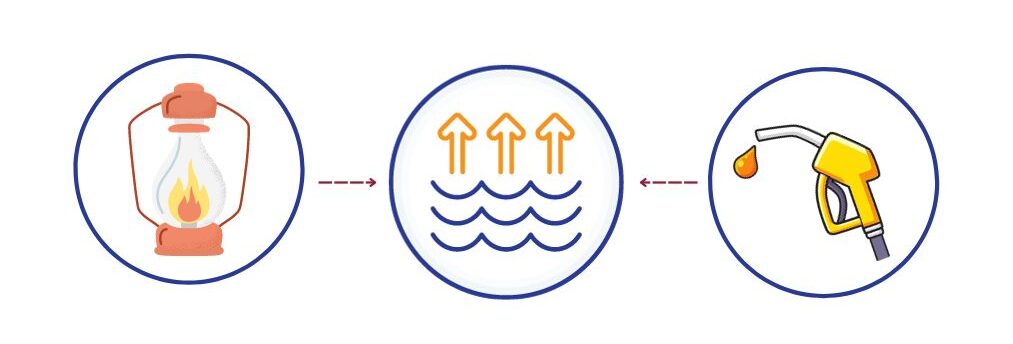Welcome to a magical journey where we delve into the mysterious world of liquid kerosene and explore the intriguing question, “Does kerosene evaporate?” Picture a tiny droplet of kerosene, as small as the period at the end of this sentence. Now, imagine it vanishing into thin air. This isn’t magic—it’s droplet evaporation.
Droplet evaporation is an essential part of how fuel works in machines like diesel engines. Like the initial droplet diameter, this process influences the rate at which kerosene evaporates. This concept is particularly important for the fuel supply system in a diesel engine, as evaporation can affect its stable and efficient operation.
The evaporation process of kerosene and its diffusion characteristics aren’t as simple as they seem. The evaporation rate changes as the ambient temperature and atmospheric pressure fluctuate. The size of the droplet, or droplet diameter, also plays a significant role. In a high-temperature environment, like inside a jet engine, the kerosene droplet could evaporate rapidly, turning from liquid fuel into kerosene vapor.
As the kerosene vapors move in the flow direction, their concentration gradually decreases due to diffusion. This diffusion ratio can alter the combustion performance of the engine. As monitored by a temperature measuring rake, the temperature gradient in the combustion area also impacts the evaporation coefficients and, hence, the fuel space distribution.
Evaporation and diffusion are more than scientific processes—they are essential parts of our day-to-day life. They are critical factors in making sure jet engines work efficiently and safely. Moreover, they ensure the most reasonable fuel distribution in our engines. They help control the combustion heat release. So next time you see a plane soaring in the sky or hear the purr of a diesel engine, remember the humble droplet of kerosene and its magical journey of evaporation and diffusion.
In the coming sections, we will delve deeper into these processes, comparing kerosene and diesel fuel and exploring the marvel of kerosene’s evaporation. So, buckle up for a fascinating journey into evaporation and diffusion!
Does Kerosene Evaporate? Decoding the Evaporation and Diffusion Process

Kerosene is like a magic liquid. You see it, and then – poof! – it’s gone.
Imagine a single droplet of kerosene. It’s small, like a tiny bead. But there’s more to it than meets the eye. This droplet has a lifetime. It doesn’t live forever. It can evaporate. This is where the droplet evaporation rate comes in.
It’s like a race against time. The evaporation characteristics depend on lots of things. One key factor is temperature. When it’s hot, like in a jet fuel engine, the droplet has a high enthalpy inflow. This is just a fancy way to say it’s getting a lot of heat. At low temperatures, the race slows down.
Another important thing is pressure. Imagine having a heavy backpack – it’s harder to move. That’s what it’s like for the droplet. When the ambient pressure is high, it’s harder to evaporate. That’s where a tool like a pressure measuring rake can help measure the pressure.
The size of the fuel droplets matters, too. Bigger droplets take longer to evaporate. We measure this using a laser particle sizer. It’s like a high-speed camera for droplets.
And what happens to the kerosene when it evaporates? It starts to spread out or diffuse. This is important in engines like a supersonic combustor equipped with a flame stabilizer. The spread of the kerosene diffusion can affect how the engine works.
All these factors – temperature, pressure, and size – can affect the evaporation and diffusion of kerosene. Understanding them is like solving a puzzle. Each piece – from the initial diameter to the ambient temperatures, from the heat shield to the cold inflow, and from the blockage ratio to the vortex nucleus – fits together to give us the whole picture.
So, does kerosene evaporate? Yes, it does. But it’s not just about disappearing. It’s about how the kerosene changes, moves, and interacts with everything around it. That’s the real magic of evaporation and diffusion!
Diesel Fuel and Kerosene: A Dance of Droplet Evaporation

Now, let’s talk about diesel fuel and kerosene. They’re like two dancers in the world of droplet evaporation.
First, let’s look at how they move. Both diesel and kerosene have a direction when they evaporate. Think of it like a dance floor. When the party is heating up, the flow direction decreases. It’s like the dancers are spreading out across the dance floor. This is thanks to the initial heating they receive.
Now, imagine the dancers spinning around. That’s like the droplet’s lifetime. The droplets don’t spin forever. They slow down and eventually stop, or in other words, evaporate. The dancers’ momentum, or the injection momentum, affects how quickly this happens.
Picture a dancer doing a spin. As they spin faster, they spread out. This is like the evaporation momentum of the droplets. As the droplets evaporate, they start to diffuse or spread out.
Now imagine that the dance floor is getting crowded. There’s less room for each dancer. That’s like when the fuel particle size gets smaller. The smaller droplets have less room to move, which affects their evaporation.
Let’s take a quick break to talk about pressure. Remember how a heavy backpack makes it harder to move? The same thing happens here. When the pressure is high, like elevated pressures, the droplets find it harder to evaporate.
Another thing to consider is the heat. When the temperatures are high, the droplets evaporate faster. This affects the heat release conditions in an engine. Too much heat and the dance floor gets too hot. Not enough, and the party slows down.
Understanding the dance of droplet evaporation helps us understand how diesel and kerosene work in engines. It’s like figuring out the moves to a complex dance. Once we know the steps, we can ensure the dance goes smoothly and our engines run efficiently.
So, next time you see diesel fuel or kerosene, remember the dance of droplet evaporation. It’s a complex ballet, but keeping our engines running is crucial!
Wrapping Up: The Marvel of Kerosene’s Evaporation
So, what have we learned about the marvel of kerosene’s evaporation?
We discovered that kerosene isn’t just a liquid. It’s a magic droplet embarking on a journey. That journey is single droplet evaporation. From the moment the droplet forms, its lifetime begins.
Remember our dancers? The speed they spin at – that’s like the injection momentum. It affects how quickly the kerosene evaporates. And as the droplets evaporate, they start to spread out. That’s their diffusion ability. It’s like dancers twirling across a dance floor.
But this dance floor is unique. It has different zones, like the recirculation zone. Here, the droplets slow down, and their movement changes.
Now imagine a dance competition. A judge is watching for the best moves. In kerosene evaporation, we have the heat release zone. It’s like the hot spot of the dance floor, where evaporation is at its maximum proportion.
And, of course, the heat. High temperatures make the droplets evaporate faster. It’s like turning up the music and making the dancers move quickly.
But this isn’t a dance of chaos. It’s a carefully choreographed ballet. We can map the spatial distribution of the droplets, like planning where each dancer should be. Tools like particle image velocimetry help us do that.
In this magical dance of kerosene evaporation, every detail matters. Each factor plays a part, from the typical kerosene components to the critical pressure. And understanding that dance helps us use kerosene more efficiently.
So, next time you think of kerosene, remember this marvel of evaporation. It’s a dance of science, and it’s happening right under our noses!






